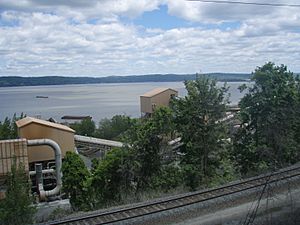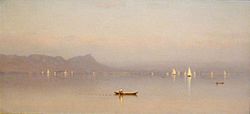Haverstraw Bay facts for kids
Haverstraw Bay is the widest part of the Hudson River in New York. It is about 3.4 miles (5.5 kilometers) wide. The bay stretches for about 5 miles (8 kilometers). On its western side is the village of Haverstraw in Rockland County. To the east, you'll find the village of Croton-on-Hudson in Westchester County.
Contents
Where is Haverstraw Bay?
Haverstraw Bay is about 35 miles (56 kilometers) north of New York City. To the west, it borders the town and village of Haverstraw. To the east, it touches parts of Ossining, Croton-on-Hudson, and Cortlandt.
A special part of the bay is Croton Point. This large piece of land sticks out almost halfway across the Hudson River from the eastern shore. It's a great spot for watching birds, especially bald eagles!
Why is Haverstraw Bay Important for Nature?
Haverstraw Bay is a very important estuary in the Hudson River. An estuary is where fresh river water mixes with salty ocean water. This mix creates a rich environment for many plants and animals.
The western side of the bay is deeper, with a shipping channel at least 32 feet deep. The eastern side is much shallower, often less than 10 feet deep. Because it's shallow and gets lots of sunlight, many water plants grow there.
Amazing Animals of the Bay
The mix of fresh and salty water brings in lots of nutrients. This helps many different kinds of animals thrive, including:
- Small water creatures (invertebrates)
- Many types of fish
- Lots of different birds
The bay is super important for the health of fish in the Hudson River. This includes the shortnose sturgeon, which is an endangered fish, and the larger atlantic sturgeon. New York State has even called Haverstraw Bay a "Significant Coastal Fish and Wildlife Habitat." This means it's a very special place for fish and wildlife along the coast.
Long ago, until the mid-1950s, Haverstraw Bay was also a great place for oysters. The health of the bay's water depends on things like rainfall, tides, and even pollution from humans. Seasonal changes in temperature and light also play a big role.
History of Haverstraw Bay
In 1609, an English explorer named Henry Hudson was looking for a shortcut to Asia called the Northwest Passage. He was sailing for the Dutch East India Company. As he sailed his ship up the river that would later be named after him (the Hudson River), the river got much wider when he reached Haverstraw Bay.
Henry Hudson thought he had found the Northwest Passage! He stopped his ship on the western shore of Haverstraw Bay. He then claimed this land as the first Dutch settlement in North America.
Important Events in the Bay's History
- In 1780, during the American Revolutionary War, a British spy named Major John André landed on the west shore of the bay. He was there to meet with Benedict Arnold, an American general who was secretly working with the British.
- In 1801, artist Charles Willson Peale traveled up the Hudson River. He made a sketch of Stony Point from the bay.
- Haverstraw Bay is also mentioned in the 1975 book My Brother Sam Is Dead by James Lincoln Collier and Christopher Collier.
Today, you can cross the bay using the Haverstraw–Ossining Ferry, run by NY Waterway.
Things to See and Do
- The Rockland County September 11 Memorial is located at Haverstraw Bay Park.



